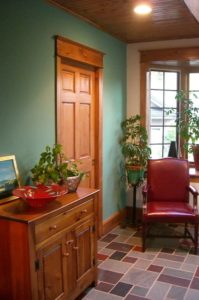Paint colors can have a huge impact on the energy efficiency of our homes. It’s more and more common these days to use white or reflective roof coatings to keep buildings cooler in summer, since a black tar roof will absorb heat rather than reflect it outward. The same basic principle goes for exterior painting: Lighter, more reflective colors will help buildings stay a little cooler during those long sunlit summer days.
But even interior color choices can affect energy efficiency. The always informative Color Matters site takes a good look at paint colors and energy efficiency. They discuss roofs and exteriors, but then also go on to discuss the two primary energy-consumption effects of interior color choices:
- Electric lighting accounts for about a quarter of the energy consumption in the U.S. Because darker walls absorb light, a room with darker paint on the walls will require more wattage to achieve whatever level of light you want.
- We almost didn’t believe this one, but objective study bears it out: Color significantly changes our perception of temperature. A person in a room with cool blues or greens tends to estimate the temperature of the room to be 6-10 degrees cooler than the actual temperature. And in rooms with warmer reds or oranges, people tend to estimate the temperature at 6-10 degrees warmer than it really is.
So we should all repaint our interiors twice a year, right? Okay, maybe that would be nice for painting contractors like us! But it is definitely something to keep in mind when thinking about how and when a room will be used. How will you feel while you’re in it… and how will you feel when you get your energy bill?
And we hope you’ll let us know when you’re ready to increase the efficiency of your home with new interior or exterior colors, or with a new white or reflective roof coating.
